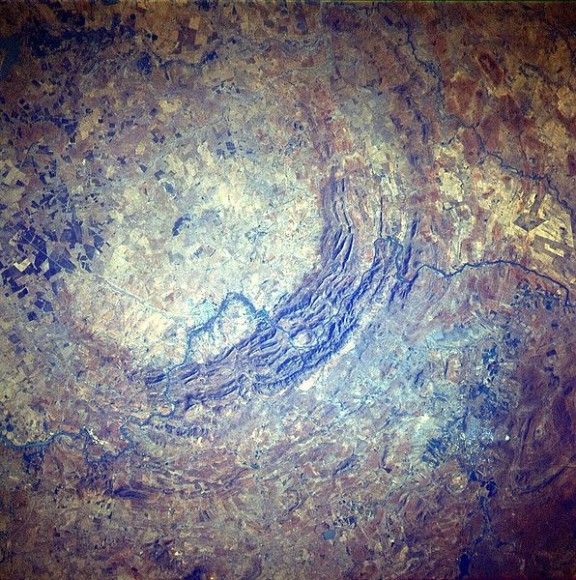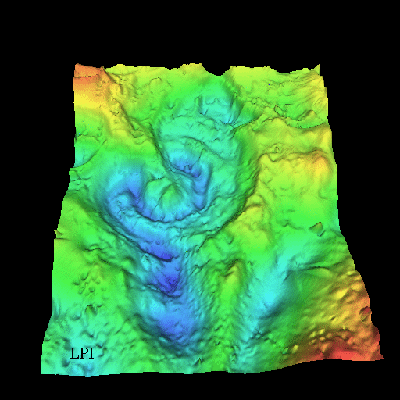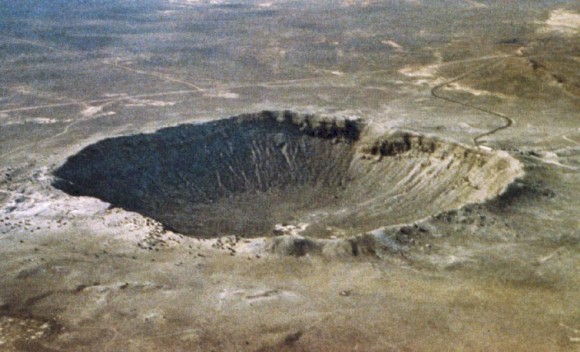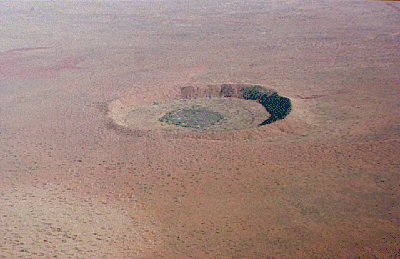
Vredefort Crater. Image: NASA
Ever since our recent encounter with asteroid 2008 TC3 — the first asteroid that was correctly predicted to hit our planet — I've had impact craters on the brain. Earth has about 175 known impact craters, but surely our planet has endured more bashing than that in its history. All the other terrestrial planets and moons in our solar system are covered by impact craters. Just look at our Moon through a telescope or binoculars, or check out the recent images of Mercury sent back by the MESSENGER spacecraft, or pictures of Mars from the armada of spacecraft orbiting the Red Planet, and you'll see that impact craters are the most common landforms in our solar system. But since two-thirds of Earth is covered by water, any asteroid impacts occurring in the oceans are difficult to find. And even though Earth's atmosphere protects us from smaller asteroids, just like in the case of 2008 TC3, which broke up high in the atmosphere, weathering, erosion and the tectonic cycling of Earth's crust have erased much of the evidence of Earth's early bombardment by asteroids and comets. Most of Earth's impact craters have been discovered since the dawn of the space age, from satellite imaging. In fact, a geologist recently discovered an impact crater using Google Earth! Here's my list of Earth's Ten Most Impressive Impact Craters, starting with #1. the largest and oldest known impact crater, Vredefort Crater, shown above, located in South Africa. It is approximately 250 kilometers in diameter and is thought to to be about two billion years old. The Vredefort Dome can be seen in this satellite image as a roughly circular pattern. What an impact that must have been! Manicouagan Reservoir. Credit: NASA Chicxulub Crater. Aorounga Crater. Credit: NASA Clearwater craters. Credit: NASA Barringer Crater. Wolfe Creek Crater Deep Bay Crater. Credit: NASA Kara-Kul Crater. Credit: NASA Bosumtwi Crater. 
2. Manicouagan Crater: fifth largest known impact crater. This crater is located in Quebec, Canada. It was created about 212 million years ago. Now, it is an ice-covered lake about 70 km across. This image, taken by space shuttle astronauts, shows an outer ring of rock. Close up, the rock reveals clear signs of having been melted and altered by a violent collision. The original rim of the crater, though now eroded away, is thought to have had a diameter of about 100 km. 
3. Chicxulub Crater, third largest and possible dinosaur killer. The third largest impact crater lies mostly underwater and buried underneath the Yucatán Peninsula in Mexico. At 170km (105 miles) in diameter, the impact is believed to have occurred roughly 65 million years ago when a comet or asteroid the size of a small city crashed, unleashing the equivalent to 100 teratons of TNT. Likely, it caused destructive tsunamis, earthquakes and volcanic eruptions around the world, and is widely believed to have led to the extinction of dinosaurs, because the impact probably created a global firestorm and/or a widespread greenhouse effect that caused long-term environmental changes. 
4. Aorounga Crater: possible triple crater. The main Aorounga Crater in Chad, Africa, visible in this radar image from space, shows a concentric ring structure that is about 17 kilometers wide. But, this crater might have been formed as the result of a multiple impact event. A second crater, similar in size to the main crater, appears as a circular trough in the center of the image. And a third structure, also about the same size, is seen as a dark, partial circular trough on the right side of the image. The proposed crater "chain" could have formed when a 1 km to 2 km (0.5 mile to 1 mile) diameter object broke apart before impact. Ouch!
5. Clearwater Craters: two for the price of one. Twin, lake-filled impact craters in Quebec, Canada were probably formed simultaneously, about 290 million years ago, by two separate but probably related meteorite impacts. The larger crater, Clearwater Lake West has a diameter of 32 km, and Clearwater Lake East is 22 km wide. 
6. Barringer Crater: well preserved. While this crater isn't all that big, what's most impressive about Barringer Crater in Arizona (USA) is how well preserved it is. Measuring 1.2 km across and 175 m deep, Barringer Crater was formed about 50,000 years ago by the impact of an iron meteorite, probably about 50 m across and weighing several hundred thousand tons. Most of the meteorite was vaporized or melted, leaving only numerous, mostly small fragments with in the crater and scattered up to 7 km from the impact site. Only about 30 tons, including a 693-kg sample, are known to have been recovered.
7. Wolfe Creek Crater, well preserved, too. Another relatively well-preserved meteorite crater is found in the desert plains of north-central Australia. Wolfe Creek crater is thought to be about 300,000 years old and is 880 meters across and and about 60 meters deep. It's partially buried under the wind-blown sand of the region, and although the unusual landform was well-known to the locals, scientists didn't find the crater until 1947.
8. Deep Bay Crater: deep and cold. Deep Bay crater is located in Saskatchewan, Canada. The bay is a strikingly circular 13 km wide impact crater and is also very deep (220 m). It is part of an otherwise irregular and shallow lake. The age of the crater is estimated to be 99 million years old. 
9. Kara-Kul Crater: high altitude crater. This crater was formed about 10 million years ago, and is located in Tajikistan, near the Afghan border. In total, the crater is about 45 km in diameter and is partially filled with a 25 km-wide lake. This might be the "highest" impact crater, almost 6,000 m above sea-level in the Pamir Mountain Range. It was found only recently from satellite images. 
10. Bosumtwi Crater: built of bedrock. The last crater on our tour of impressive impact craters is this located in Ghana, Africa. It is about 10.5 km in diameter and about 1.3 million years old. The crater is filled almost entirely by water, creating Lake Bosumtwi. The lakebed is made of crystalline bedrocks.







0 comments:
Post a Comment